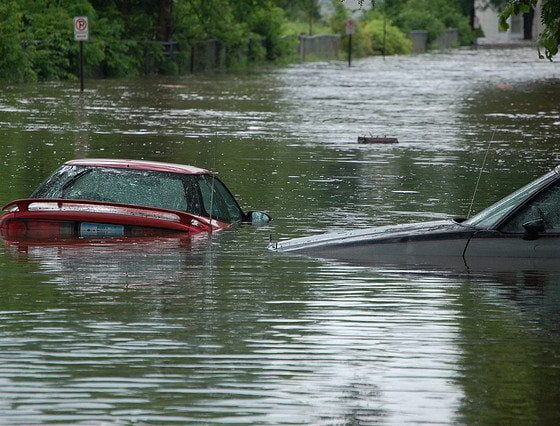

Environment
The Hidden Prejudice of Climate Change
It’s National Hate Crime Awareness Week, and the spotlight is being turned on violent prejudice to receive the condemnation it deserves. Equality and accessibility are rightfully demanded in every area of day-to-day life – so why are they being overlooked when it comes to environmental policy? Kate Hawkes, a blogger and marketing assistant with Irish eco-business Celestial Green Ventures, writes.
The facts surrounding climate change point towards an acceptance of marginalisation from the highest levels of influence. In a recent article I explored how, to my outrage, man-made limitations are making women more vulnerable to the effects of climate change – but the global climate gap runs wider still. Countless studies on global warming note that ‘climate change is having the largest impact on the world’s (…) most vulnerable people’. Primarily, this is due to poverty, insufficient education and limited mobility, but these in turn are often the result of restrictions and stigma attached to aspects of identity, including disability, age, ethnicity, or indeed gender. What most studies ignore is why this vulnerability to climate change is allowed to continue – and what this reveals about attitudes towards diversity.
To blame vulnerability on physiology is to give up too easily. With regards to age and disability, physical factors may alter the way that climate-induced natural disasters have to be approached, but they certainly don’t present an unsurmountable barrier. The social model of disability states that a person is disabled by society’s expectations and lack of provision, not by their impairment. A wheelchair user may be disabled from entering an emergency shelter accessed by stairs, but given a ramp they are perfectly able to do so. Similarly, whilst an older person with impaired hearing might not be alerted by an earthquake warning siren, an adapted system that uses a visual signal enables them to receive the same urgent message. The disabling factor putting individuals at risk is the lack of accessibility provision, rather than their age or impairment.
Yet, despite authorities echoing the need for provision to suit these groups, many who have had first-hand experience complain that disaster response teams are unsure how specifically to put this into action, or lack the equipment to do so. One New York resident was trapped in her apartment for six days during Superstorm Sandy in 2012, unable to be evacuated because there was no transport available that could handle her wheelchair, and no electricity for her to power it.
As ever, it comes down to cold, hard cash. Alternative, accessible solutions are available, but at a price, and often those who need additional support are amongst the lowest income groups. One of the reasons that older people are less able to adapt to extreme weather such as heatwaves or snowstorms is that many live in older, poorly insulated properties with low energy efficiency, and can’t afford to adequately heat or cool their homes. 20% of the world’s poorest and most vulnerable people are disabled in some way, and estimates suggest there are around 785 million disabled people globally. These numbers are set to rise: many of the world’s wealthiest countries have aging populations, and the potential consequences of climate change, including conflict and malnutrition, could cause people to become disabled.
Clearly, it makes sense to be investing the time and money sooner rather than later. “When they’re building up the infrastructure, including after a natural disaster, they should make it accessible,” notes Sophie Mitra, an associate professor of economics, “That’s much easier and cheaper than retrofitting it.” Investment in these areas could also help slow the progress of climate change by reducing emissions. The oldest members of society currently have the highest climate impact per pound spent, because high-emissions home heating represents 40% of their carbon footprint. Disabled people are often forced to use private transport because the lower-pollution option, public transport, simply cannot accommodate their needs.
Despite the logic behind building specific solutions, a Global Partnership for Disability and Development (GPDD) e-discussion on the Impact of Climate Change on People with Disabilities noted a ‘lack of international guidance, through the international coordination mechanisms’. A UN briefing document from the 2012 Conference on Sustainable Development encouraged an approach to climate change that is ‘sensitive to impacts on vulnerable populations including the poor, the elderly and the persons with disabilities.’ This generalising view doesn’t inspire confidence in specific solutions that are not merely sensitive to differences but effective in coping with the individualities of each scenario.
The term ‘vulnerable’ is often used to neatly sidestep the issue of where this susceptibility arises from. An increase in global temperatures would expose each of us to similar risks, discriminating only according to geography. ‘Actual vulnerability is socially constructed,’ the GPDD report concludes, ‘i.e. it is dependent on (…) socio-economic conditions and the available resources and infrastructure’. Parallels can also be found with regards to ethnicity, albeit with sparse research on the topic so far, possibly due to its particularly sensitive nature. However, a 2013 study suggests that minority ethnic groups in the United States experience increased heat-susceptibility due to ‘social and economic disparities, living conditions, language barriers, and occupational exposure’.
If the capability exists to protect everyone against the effects of climate change, regardless of age, disability, gender or other aspects of identity, it leaves the uncomfortable question of why it isn’t being put into practice. This silent prejudice seems to boil down to the fact that those who are going to be hardest hit are also those who are able to do the least to protest against it. Having a low income and limited mobility not only puts people in the line of climate change, it also puts them out of sight of policy makers, who seem to have decided that climate change is already complicated and expensive enough, thanks. National Hate Crime Awareness week is an ideal time to recognise the discrimination that is happening by default because we are allowing it to remain hidden behind the term ‘vulnerable’, and to continue forming the shaky foundations of environmental policy.


 Environment10 months ago
Environment10 months agoAre Polymer Banknotes: an Eco-Friendly Trend or a Groundswell?

 Environment11 months ago
Environment11 months agoEco-Friendly Home Improvements: Top 7 Upgrades for 2025

 Features9 months ago
Features9 months agoEco-Friendly Cryptocurrencies: Sustainable Investment Choices

 Features10 months ago
Features10 months agoEco-Friendly Crypto Traders Must Find the Right Exchange





















